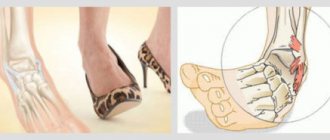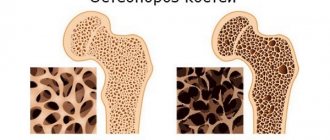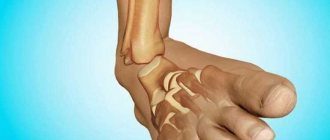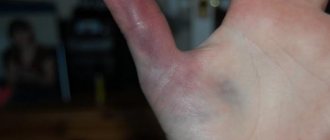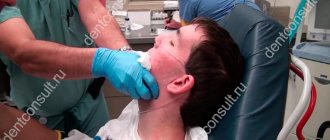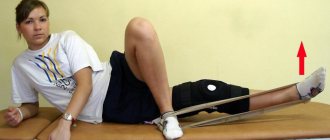Congenital hip dislocation is a serious pathology of the musculoskeletal system caused by joint dysplasia. Failure in the development of various parts of the femoral joint occurs during intrauterine development. According to WHO, this disorder occurs in approximately 3% of children, and in girls it is observed 5 times more often than in boys. At first, the symptoms appear very mild, but over time the pathology begins to progress rapidly. Without proper treatment, the hip joint is completely destroyed. A timely visit to a pediatric orthopedic traumatologist will allow you to successfully cope with the problem so that the child can develop harmoniously in the future.
Classification of congenital hip dislocations
Depending on how severe the pathology is, there are several types:
- Immaturity of the hip joints. This is the very initial stage of the pathology, in which the deviation from the norm is still minimal. The tissues and parts of the movable femoral joint remain incompletely formed, and their underdevelopment is observed. In most cases, it occurs in premature babies, however, it is sometimes diagnosed in those babies who were born according to their due date. This pathology can occur without symptoms and is determined only by ultrasound.
- Pre-dislocation. This is the first degree, in which the articulation of the joint components is developed correctly, however, the presence of dysplasia prevents its normal development.
- Subluxation (second degree). With this type of pathology, the head of the femur does not coincide with the acetabulum, being only partially located in it. However, the child continues to grow and begins to move more and more actively, so the deviation from the norm only gets worse.
- Dislocation of the hip joint (third degree). The head of the femur completely loses contact with the acetabulum on one or both sides. The first variant of pathology develops much more often.
Complications after injury
If this pathology is untimely or improperly treated, serious complications can develop. This happens if the victim did not immediately consult a doctor or did not follow all his instructions.
Due to prolonged incorrect position of the femur, the following consequences appear:
- most often arthrosis develops - destruction of cartilage tissue in the joint area;
- with incorrect or untimely reduction, necrosis of the bone head develops;
- As a result of dislocation, there may also be damage to nerves and blood vessels, ankylosis of the joint or the development of arthritis.
A hip dislocation is a fairly serious injury. Only with timely consultation with a doctor and following all his recommendations is it possible to fully restore the functions of the composition.
Causes
WHO experts identify several causes of congenital hip dislocation. These include:
- An intrauterine anomaly in the development of the femoral joint, starting with improper formation of tissues from which the joint and its capsule should subsequently be formed.
- Incorrect presentation of the fetus. This is especially dangerous if the woman is giving birth for the first time. The risk group includes pelvic and breech presentation (the hips are bent and the knees are extended).
- Genetics. In approximately 25-30% of cases, this pathology is inherited.
- The presence of various diseases during pregnancy also affects the incidence of such abnormalities. These may be gynecological pathologies (fibroids, adhesions in the uterus) that interfere with normal fetal mobility, as well as various viral and bacterial infections.
- Lack of vitamins and minerals in the diet. Deficiencies of iron, calcium, iodine and phosphorus, as well as vitamins E and B, are especially acute.
- Bad ecology. Radiation poses a particular danger. Under its influence, large-molecular chromosome cells are damaged, which provokes the development of intrauterine defects.
- Hormonal imbalance in the mother's body. In the last weeks of pregnancy, progesterone production increases sharply. This hormone weakens the ligamentous apparatus. Often after childbirth, when progesterone can no longer influence the child’s body, the dislocation corrects itself and the joints stabilize.
Advantages of treatment at Top Ikhilov
By choosing the Top Ichilov Clinic for treatment, you get the following benefits:
- Treatment by highly qualified doctors
, many of whom are eminent specialists in the country. - High-tech equipment
. This is especially important to emphasize in relation to surgery of the limbs and joints. In their practice, Top Ikhilov surgeons use minimally invasive techniques that are not accompanied by significant blood loss and injuries. - Russian speaking staff
. At Top Ichilov, many doctors are fluent in Russian, so you will not have problems with communication, which is very important. However, if necessary, we provide our patients with a professional translator.
- 5
- 4
- 3
- 2
- 1
(1 vote, average: 5 out of 5)
Symptoms
The main symptoms of congenital hip dislocation are:
- Different range of motion in the hips (can be observed on one or both sides). The leg becomes poorly mobile at the joint. Normally, the child’s hips are easily moved to the side by 80-90°. If there are disturbances, the abduction angle decreases to approximately 40° and a rather tight resistance of the femoral joint is felt.
- "Click" symptom. It only appears in babies under 3 months of age. The legs are bent at right angles at both the knees and hips, and then carefully moved in different directions, while on the side where there is subluxation in the joint, a characteristic click is heard and a trembling of the leg is felt. This click may be subtle or quite loud.
- Different leg length ratios. The child's legs are bent at the knee and hip joint and pressed symmetrically to the stomach. As a result, the knees will be at different levels: on the decreasing side there is dysplasia.
- Asymmetrical skin folds. The legs should be completely straight. If the movable joints are developed correctly, then the front inguinal folds will be symmetrical to each other. From behind, control is carried out along the gluteal and popliteal folds, which should also be at the same level.
- External rotation of the leg. On the dislocated side, the foot will be turned outward.
The presence of these symptoms is typical for children under 1 year of age. At older ages, the clinical manifestations of the disease are slightly different:
- Gait is disturbed.
- A Duchenne-Trendelenburg symptom appears. The child needs to stand on the sprained leg and bend the healthy leg at the knee and hip joint by 90°. If there is pathology, the pelvis will tilt in the healthy direction, and the gluteal fold will descend. If there is no anomaly in the development of the femoral joint, then the pelvis will not descend, and the folds in the buttocks will remain at the same level.
- The greater trochanter of the femur is located above the Roser-Nelaton line.
- Symptom of non-disappearing pulse. By pressing on the femoral artery under the Pupart's ligament, the pulsation of the peripheral vessels is checked. If the head of the hip joint is in place, then when pressed tightly, the pulse disappears. In case of dislocation, the head is displaced from its natural position, and the artery, under the pressure of the finger, falls into the soft tissue, and the pulse in the peripheral vessels continues to be clearly felt.
Parents can detect some of these symptoms on their own while bathing or changing their child. However, not all of the above signs appear clearly and clearly. And the presence of any individual symptom is also not one hundred percent a sign of hip dislocation, since in the first months of a newborn’s life the presence of some symptoms is the norm. An experienced traumatologist will be able to make an accurate diagnosis.
What happens with congenital hip dislocation?
This pathology always appears in parallel with dysplasia of mobile joints. Due to existing disorders, the joint is not adapted even to such a standard load as walking. Its components take an incorrect position, and under the influence of the load, the head of the femoral joint comes out of the acetabulum. As a result, the empty space in it is filled with scar tissue. The head of the femur still needs support and chooses another part of the pelvic bone for this, forming a new articular cavity on it.
Such changes affect the entire body. As a result, the tone of the muscles of the buttocks and back changes, the pelvis becomes skewed, which entails curvature of the spine, as the body tries to regain its balance. All these changes are very dangerous: at first, walking becomes difficult, then severe deformation of the joint begins, causing it to lose its shape and proportions. This leads to contracture (stiffness), and in the future can lead to complete loss of mobility. Pain in the joint is added, so that the child will not be able to lean on the sprained leg at all. For proper development, a child needs sufficient physical activity, only in this way will his musculoskeletal system be able to fully function, and the baby himself will explore the world, moving freely and playing with peers.
Possible complications
In itself, congenital hip dislocation is already a complication that accompanies hip dysplasia. With timely diagnosis, pathology can be identified at the stage of minor and reversible changes and complications can be prevented.
If time is lost, dire consequences will appear. One of the most dangerous is deforming osteoarthritis of the hip joint. The disease leads to the destruction of the femoral joint and its complete dysfunction. The pathology is characterized by severe pain, which is felt both in the affected joint and in other parts of the skeleton, since the load will necessarily be redistributed.
With congenital dislocation of the hip, one leg is much shorter than the other. As a result of this disproportion, other mobile joints also begin to develop incorrectly. It will be quite difficult for the child to learn to walk, and in severe cases, walking will become simply impossible.
The appearance of complications greatly aggravates the situation, because correcting them is quite difficult. Doctors are forced to resort to surgical intervention: this is a large-scale, traumatic and multi-stage process, the outcome of which in many cases is unpredictable. Even if the operation is successful, the patient will face a long recovery period. Complications can affect the hip after endoprosthetics: the prosthesis remains unstable, and there is a high risk of re-dislocation and gait problems.
Diagnostic methods
After contacting the clinic, the following actions are usually performed:
- Anamnesis collection. The doctor collects all the necessary information about the pathology, starting with information about how the pregnancy proceeded, whether the mother had health problems, what the presentation of the fetus was, whether there is a hereditary predisposition to hip dislocation. If a child already has some orthopedic pathologies, for example, clubfoot or congenital muscular torticollis, then special attention should be paid to him, as these are prerequisites for the development of problems with the hip joints.
- Visual inspection. It allows you to see the manifestation of various symptoms of dysplasia and dislocation. Ideally, it is best performed 4-7 days after birth.
- Ultrasound. This procedure is performed on one-month-old babies using the method of R. Graf. The specialist evaluates the cartilaginous component of the femoral head and acetabulum, which are non-radiographically opaque. It is also important to obtain the most complete information about the morphology of the femoral mobile joint and its stability.
Features of treatment at different stages
At the immaturity stage, therapy consists of wide swaddling if the diagnosis was made by ultrasound. After a month of swaddling, it is necessary to do a follow-up examination to see how the condition of the joint has changed. In some cases, immaturity is noticed due to limited expansion in the hip joints. Doctors recommend using a spacer splint for 30 days and then checking for changes in the condition.
In case of pre-dislocation, fixation of the hip joints is required. For this purpose, special orthopedic devices are used:
- Freyka's pillow. It is effective in treating babies up to 3 months. The name of the pillow is very arbitrary, since in design it is rather a soft cushion, with the help of which the legs are easily fixed in the spread position. The structure is secured to the child’s body using wide and soft straps, like in overalls. They do not pinch the skin, do not restrict hand movements and do not cause irritation.
- Pavlik stirrups. This is a special belt made of soft material, fixed on the chest, additionally equipped with knee and shoulder straps. Using this device, soft fixation of the legs is ensured: that is, the baby can move his legs, but only in a strictly defined direction and with a limited radius, which will contribute to the correct development of the femoral joint. For the first time, the doctor puts on the stirrups and makes special notes on the straps for the parents. They will become reference points in the future. At first, Pavlik’s stirrups cannot be removed even while swimming. It is better to purchase an additional set and quickly put a dry product on your baby after water procedures. The orthopedist may also recommend abstaining from bathing at first, replacing it with drying. In order for the baby to feel as comfortable as possible, air procedures are also carried out at the same time: to do this, it is necessary to remove all his clothes and let him lie down for some time at room temperature. You cannot use wet stirrups, as they will injure delicate skin.
- Abduction splint-spacer. The tire consists of two flannel cuffs, between which there is a special spacer stick placed in a fabric cover. The cuffs are secured to the legs just above the ankles (about 2-3 cm) and a spacer stick is sewn to them. It must have a certain size that exactly corresponds to the distance between the ankles during non-violent hip extension. The course of therapy lasts from 3 to 4 months.
For subluxation and dislocation, the same treatment methods are used. The duration of therapy can be 4-6 months. If a child receives all the necessary care in the first three months of life, then the chances of a full recovery are very high. At older ages, treatment will be more difficult. The orthopedist uses combined techniques: at the initial stage, they use a splint-spacer (from 14 to 28 days), then they do an ultrasound or x-ray and replace the structure with a lightweight plaster cast.
Surgery is resorted to when hip dislocation has been diagnosed in a child over 2 years of age and complications are observed. The operation can be extra-articular, intra-articular or combined. The doctor chooses the most optimal option based on the examination results. It is impossible to let the pathological process take its course, as complications will appear in the future that will complicate treatment.
Congenital hip dislocation is a serious pathology that cannot be ignored. It will only progress, worsening leg mobility and depriving the child of full physical activity. To reduce the risk of developing abnormalities, a woman during pregnancy needs to eat right, eliminate all bad habits and visit a gynecologist within strictly established periods. After the birth of a child, it is necessary to immediately check the joints for the presence of dysplasia. At the first signs of pathology, a consultation with an orthopedic traumatologist is indicated. In the early stages of the disease, in most cases, conservative treatment is used, which is the most gentle for the child.

